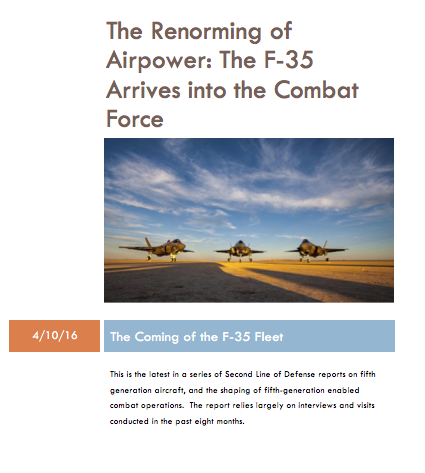2016-04-06 This report provides an update of the roll out of the F-35 as of March 31, 2016.
The report is based on interviews with pilots, maintainers, testers and industrialists involved with the program.
The F-35 is not a future program; it is here now.
The Marines already have their initial aircraft, the USAF is about to declare their first squadron ready for combat and the US Navy will follow next year. Several partners in the program are flying and maintaining their initial aircraft at places like Luke AFB or Beaufort Marine Corps station.
And those same allies, have built or are building infrastructure in their countries for the roll out of the F-35 in their countries, as well as to support those of allies which will operate when appropriate off of their national airbases.
According to the F-35 Joint Program Officer, there are currently more than 250 F-35 pilots and 2,400 aircraft maintainers from six nations already trained and more than 110 jets are jointly under construction at the Fort Worth and Cameri production facilities.

F-35s are flying at eight operating locations: Edwards Air Force Base, California, Eglin AFB, Florida, Hill AFB, Utah, Luke AFB, Arizona, Marine Corps Air Station Beaufort, South Carolina, MCAS Yuma, Arizona, Naval Air Station Patuxent River, Maryland, and Nellis AFB, Nevada. Jets are also flown at two F-35 depot locations at MCAS Cherry Point, North Carolina, and the Ogden Air Logistics Complex at Hill AFB, Utah.
And we learned at Edwards AFB in meetings with maintainers, that more than 150 F-35s are already feeding data into the F-35 digital data base, as part of shaping the way ahead for the maintenance of the fleet.
The F-35 is a “flying combat system” rather than a classic tactical fighter.
It is capable of fighting across the range of military operations and can do so rapidly in a multi-tasking mode.
That is, the impact of using F-35s is that one can deploy a force with a lighter logistical footprint, with greater coalition combat capabilities and operate across the ROMO (Range of Military Operations).
As a fleet, the F-35 is an integrated fleet able to share data over great distances via the its wave based communications systems.
And it comes as Western forces are augmenting their ability to network forces and to prepare for the next generation of weapons, and learning how to off board weapons, that is one platform identifying targets and guiding a weapon launched from another platform to the target.
The F-35 is the first software upgradeable tactical jet ever built; and the evolution of the software will be determined by the operational experiences of the air combat force.
But the F-35 is not a replacement aircraft; and it will operate with selective legacy aircraft in shaping concepts of operations innovations; but legacy assets will be modernized with regard to the shift in fifth generation warfighting fostered by the introduction of the F-35 global fleet.
Although not a replacement aircraft, there are significant improvements in the design of the aircraft which make it more affordable and viable going forward, including the intersecting R and D into the fusion cockpit as well as the fact that the F-35 is the first 8,000 combat hour operational tactical aircraft ever built.
The F-35 is also the first generation of shaping a globally sustainable tactical aircraft whereby global sourcing and support will be available.
This means that one nation’s F-35s can be maintained at the point of attack with other nation’s support structures.
This means that the sustainability of a nation’s force at an expeditionary point of attack can be supported by the global enterprise.
The F-35 is a foundational element in the reshaping of 21st century warfighting approaches whereby the ability of a coalition force to operate in the expanded battlespace is crucial for mission success.
The F-35 fusion engine has built into a range of integrated capabilities, which allows to operate in combat areas where legacy jets simply can not unless they are aided by a range of specialized aircraft, such as a jamming assets.
In effect, the introduction of the F-35 shapes a two fold dynamic.
First, co-modernization with other air combat assets or highlighting which modernizations in legacy systems are worth the effort and second, shaping dynamic combat learning with the F-35 as the learning aircraft at the center of the effort.
Put bluntly: If you are not in the F-35 learning curve you are staying in the past three decades of warfare.
Several of the aspects introduced here are discussed in more detail by those who are actually using the aircraft and evolving the systems onboard the aircraft.
We are drawing largely upon visits and interviews over the past six months in this report but the website has several years of coverage which can be referenced by our readers.
Please enter your name and email below and you will then be able to download the report directly.
Rethinking China Policy

